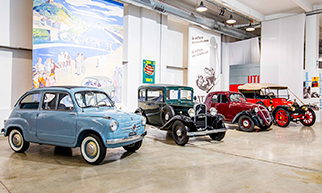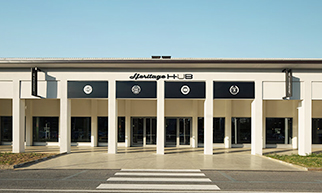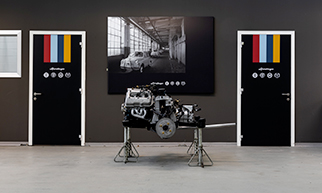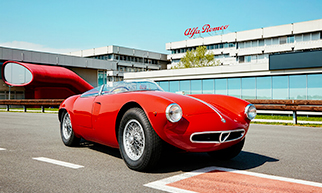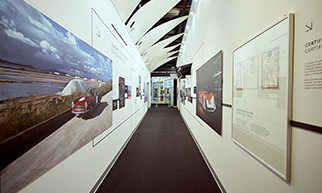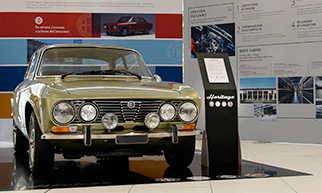Today, Italy is entering its long-awaited Phase 2 reopening. 70 years ago, also on the 4th of May, Italy revitalised its post-war motorcar market, setting off a process that soon triggered a decades-long industrial and economic boom.
“1950 has been the year of Italian innovations”, wrote the journalist Pier Luigi Sagona in the sector publication “L’Automobile”. His colleague Giovanni Canestrini declared that the 1950 Turin event was the “renovation motor show”. The 32nd Motor Show was held in the Turin Exhibition Centre from May 4th to 14th and was inaugurated by Italy's President Luigi Einaudi. It provided a perfect international showcase for simultaneously presenting three new Fiat, Lancia and Alfa Romeo models, all created ex novo after the war. Thanks to the ample 15,000 square meters of display space, the event attracted 300 exhibitors, including 46 car manufacturers from 7 participating nations.
Fiat was also celebrating its first half century: it proudly exhibited a 3 1/2 HP model from 1899, but above all presented its new 1400, in both sedan and convertible versions. This was a truly avant-garde car. It was the first Fiat unibody model, and came equipped with a standard heating system included. It boasted an extremely comfortable and spacious interior - easily accommodating six passengers - and a highly elastic engine providing rapid acceleration. It was also equipped with an innovative suspension system that guaranteed excellent road-holding at high speeds. Up until then, similar features had only been available on higher displacement and higher segment cars. The design of the 1400 also broke with Fiat tradition, being inspired by the lines of the international pontoon style then in vogue, and introducing explicit echoes of American automobile aesthetics.
Lancia’s new creation, the Aurelia, was also impressively innovative. It was exhibited in sedan and convertible versions on a revolving flowerbed, alongside a naked chassis that gave viewers a clearer vision of its various mechanical groups. The Aurelia had been previously presented to a small circle of VIP guests and journalists on April 16. It inaugurated a line of Lancia cars bearing the names of the Roman consular roads: in the 1950s it was followed by the Appia and later the Flaminia. The Aurelia replaced a glorious forerunner, the Aprilia (but incorporated the simple modern lines of the Aprilia Bilux sedan version created by Pinin Farina) and introduced various newly updated technical solutions. Of these, the most important was the engine, designed by the engineer Francesco De Virgilio: with a displacement of 1754 cc, it offered the first standard-fitted V6 in motoring history. Performance, spaciousness, dimensions and suspension were all notably improved in comparison to the Aprilia. Even the lines evolved and softened, but the iconic shield grille was maintained, although slightly rounded.
The new Alfa Romeo sedan also made its debut in Turin... but not in an official capacity. The 1900 - advertised as "the family car that wins races" - was officially presented to the press later in Milan, on October 2nd, on the eve of the Paris Motor Show... but a prototype had made a test trip to Turin on May 4. There it was exhibited in Parco del Valentino just outside the Turin Exhibition building containing the Motor Show, where the Alfa 6C 2500 was displayed on the stand inside. The 1900 too made use of the structural innovation of the unibody: it was the first Alfa Romeo car to feature this solution and also the first to be produced on the assembly line in the Portello factory. The other momentous innovation lay beneath the bonnet: here, after decades of 6-cylinder engines, Alfa Romeo invented an unprecedented 4-cylinder in-line twin-shaft of 1884 cc with aluminium heads. The engine delivered 80 HP and maximum speed reached roughly 150 km/h. The external lines were elegantly sober, with soft curves shaping the three-volume bodywork and, naturally, the typical Quadrifoglio four-leaf clover on its chromed grille, in classic Alfa style. A further first of the 1900 was the adoption of left hand drive, a revolution for Alfa Romeo.
At the 1950 Turin Motor Show, the new concept of a medium-sized sedan was explored in three different forms, representing an invitation for the middle class to participate in a new phase of postwar wellbeing.
The same event also introduced a new car manufacturer, on the verge of becoming famous for its passionate focus on performance and its countless racing successes. For the first time in its history, the newly launched Abarth brand, founded in March 1949, participated in an international Motor Show, displaying the 204A model that had won the Intereuropa Cup in Monza... and the first examples of an accessory that would make the company famous in the decades to come: its famous silencers.
The following decades also brought a long prosperous chapter in Italian history, known as the “economic boom”. Every widespread success begins with a new departure: ambitious, farseeing, but above all fuelled by fresh and revolutionary ideas.
